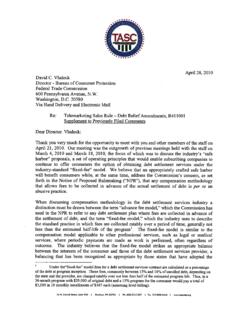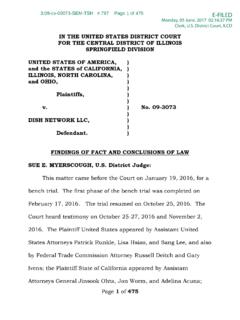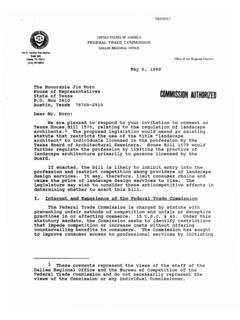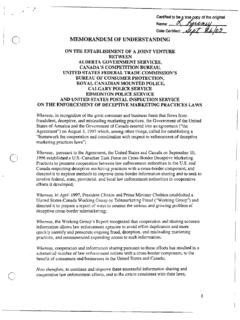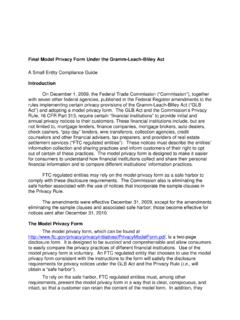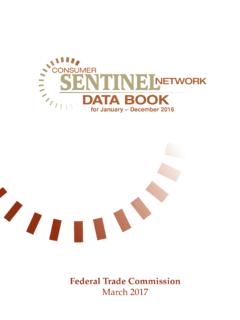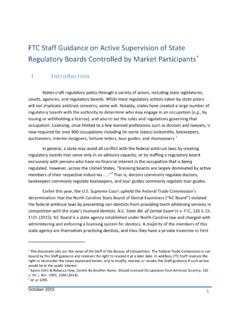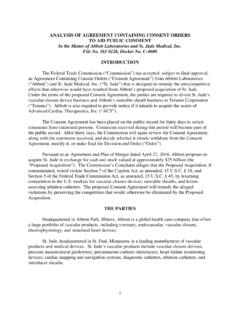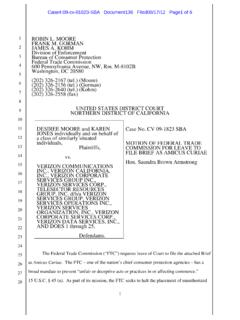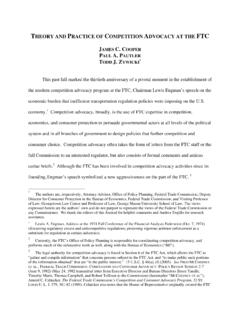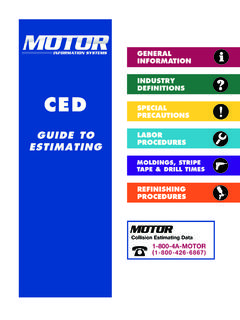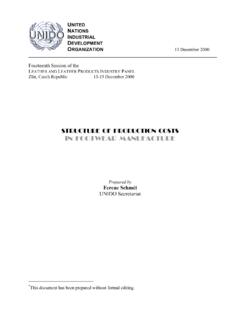Transcription of GROUP PURCHASING ORGANIZATIONS - Protecting …
1 GROUP PURCHASING ORGANIZATIONS : How GPOs Reduce Healthcare Costs and Why Changing Their Funding Mechanism Would Raise Costs A Legal and Economic Analysis Dan O Brien, Jon Leibowitz, and Russell Anello Table of Contents I. Executive summary ..3 II. Introduction ..5 The GPO Safe GPOs reduce healthcare costs ..6 Competitiveness of the GPO Effects of vendor funding of The neutrality principle ..7 Transaction costs ..7 Addressing concerns about vendor funding ..7 Summary ..10 III. Federal policy toward GPO funding ..11 IV. GPOs reduce healthcare Evidence of healthcare cost reductions ..13 Transaction cost Sources of transaction cost How transaction cost savings reduce healthcare costs.
2 16 Lower prices through joint Stronger bargaining positions ..18 Volume and other More intense supplier V. Nature of GPO competition ..23 Measuring competitive Insufficiency of standard concentration measures ..24 The numbers equivalent ..24 Calculating competition in the healthcare procurement VI. GPO funding and the economics of tax The neutrality principle ..27 Implications of the neutrality principle for GPO VII. VIII. Appendix: Numbers Equivalent Calculations for IX. X. The 1 2 I. Executive summary1 GROUP PURCHASING ORGANIZATIONS (GPOs) are companies that negotiate prices for drugs, devices, and other medical products and services on behalf of healthcare providers, including hospitals, ambulatory care facilities, physician practices, nursing homes, and home health agencies.
3 Often, GPOs are owned by their member They do not take title to or possession of medical products. Rather, the central purpose of GPOs is to enhance the quality of the services delivered and lower their members operating costs by reducing transaction costs and negotiating lower prices for supplies than providers might otherwise obtain on their own. As part of improving efficiency in the supply chain, GPOs also provide a range of additional services to healthcare providers that may lower costs or improve operations. This paper examines empirical evidence and applies economic analysis to assess whether GPOs operate competitively and reduce healthcare costs. The paper further examines a common GPO funding mechanism administrative fees paid by vendors which Congress has authorized to help GPOs cut healthcare costs. We reach the following conclusions: 1. GPOs save money for healthcare providers, patients, and taxpayers. GPOs negotiate contracts between medical supply and services vendors and healthcare providers, including hospitals.
4 In that role, GPOs create value by lowering transaction costs (for example, eliminating thousands of negotiations) and negotiating lower prices. Customer surveys show that providers realize savings of 10% to 18% by using GPOs, measured relative to the costs providers would have incurred if they negotiated prices on their own. These savings are likely to be especially valuable to smaller, rural hospitals, which may benefit relatively more than larger hospitals from GPO services. Providers pass these savings on to patients and ultimately to taxpayers. 2. GPOs promote competition in the market for procurement services. Providers can choose from multiple GPOs, and they also can, and commonly do, use multiple GPOs simultaneously. Providers often own and control their GPOs, and they can also procure supplies directly from vendors. As a result, the supply procurement market is highly competitive. 3. The current GPO funding model helps support competition and lower costs for providers, patients, and taxpayers.
5 Vendor funding is neutral compared to provider funding with respect to efficiency, except where collecting fees from vendors cuts transaction costs. In those cases, vendor funding is a more efficient means of funding GPOs. Vendor funding is common in comparable industries, and, for GPOs, collecting fees from vendors is likely more efficient than other mechanisms. 1 This paper was funded by the Healthcare Supply Chain Association. 2 For example, Vizient, the largest GPO in the United States, is member owned. Premier, the only publicly traded firm among the four largest GPOs in the United States, is owned in part by members, who control 74% of voting shares. See Premier, Inc., 2015 Annual Report [hereinafter Premier Annual Report ], 40, available at 3 Accordingly, we find compelling evidence that GPOs have created value in the marketplace, and we find that vendor funding, which Congress authorized 30 years ago, has contributed to that value.
6 Altering the current GPO funding mechanism would likely have adverse effects on providers, consumers, and taxpayers. ** 4 II. Introduction The GPO Safe Harbor The history of federal policy regarding GPO administrative fees shows that policy makers recognize that GPOs create substantial efficiencies and should be permitted to operate based on their traditional vendor-funding model. Both Congress and the Department of Health and Human Services (HHS) recognize the need for efficient pricing institutions to constrain healthcare costs. The statutory clarification for GPOs (GPO Statutory Clarification)3 enacted by Congress and the subsequent codification of this provision in the HHS safe harbor provisions (GPO Regulatory Safe Harbor) clarified the legality of administrative fees paid by vendors to At the time the GPO Statutory Clarification was enacted, no court had ever found that vendor fees paid to a GPO constituted a kickback under the Anti-Kickback Statute (AKS).
7 Nevertheless, the Justice Department and the HHS Office of Inspector General (OIG) declined to offer an advisory opinion on the subject of vendor fees. Congress therefore felt it was important to resolve any uncertainty about the GPO business model by clearly excluding vendor fees from the AKS. In considering the GPO Statutory Clarification, the House Budget Committee explained that GPOs could help reduce health care costs .. and that a safe harbor should be established to ensure that GPOs and the vendors with which they contract do not risk prosecution as a result of the payment and collection of administrative fees. 5 Thus, Congress affirmed the legality of vendor-paid fees with the intent of allowing the GPO industry s efficient, cost-reducing pricing institutions to arise. The economic analysis in this paper supports this reasoning and explains why altering the funding mechanism would be inefficient. 3 The GPO Statutory Clarification, 42 1320a-7b(b)(3)(C), has also been referred to as a safe harbor provision or as a statutory exception.
8 See, , Government Accountability Office. GROUP PURCHASING ORGANIZATIONS : Funding Structure Has Potential Implications for Medicare Costs (Report GAO-15-13, General Accountability Office, Washington, DC, 2014) [hereinafter GAO (2014) ], 7 note 13. We do not adopt that terminology in this paper. 4 The AKS, passed in 1972 as an amendment to the Social Security Act, made it illegal to pay or receive money to induce the referral of business and orders for purchases reimbursable under Federal healthcare programs. See 42 1320a-7b(b)(1) (2). In the years after the statute was passed, the legality of vendor fees and other GPO contracting practices came into question. Recognizing that expansive enforcement of the AKS could prevent efficient business transactions, Congress enacted clarifications and exceptions to the statute in 1986 (the GPO Statutory Clarification); see Omnibus Budget Reconciliation Act of 1986, Pub. L. No. 99-509, 9321(a), 100 Stat.
9 1874, 2016 (Oct. 21, 1986) (codified at 42 1320a-7b(b)(3)(C)); Rep. No. 991012, at 309 (1986) (Conf. Rep.). In 1987, Congress instructed HHS to establish regulations creating safe harbors from the AKS; see Medicare and Medicaid Patient and Program Protection Act of 1987, Pub. L. No. 100-93, 14, 101 Stat. 680, 697 (1987). This resulted in the modern GPO Regulatory Safe Harbor; see 42 (j). 5 See GAO (2014), p. 2. 5 GPOs reduce healthcare costs Recent surveys of healthcare providers show that GPOs reduce healthcare As described in Part IV, hospital executives state that GPOs reduce the cost of their healthcare supplies by 10% 18%. Economic theory indicates why GPOs are likely to reduce costs: providers voluntarily decide whether to join a GPO and, after joining, decide whether to purchase any particular item under the GPO contract or under a contract obtained directly from a supplier or another GPO.
10 A healthcare provider would have no incentive to become a GPO member or choose to make purchases through a GPO if these strategies increased its costs or inefficiently reduced its supply choices. This incentive structure provides a strong basis to expect that GPOs reduce, rather than increase, providers costs. This conclusion is well supported in the economic literature, which identifies at least two mechanisms through which GPOs could reduce providers operating costs and thereby reduce healthcare costs: transaction cost savings and lower prices from larger discounts. Competitiveness of the GPO market Evidence indicates that GPOs operate in a highly competitive market. Many national, regional, and local GPOs compete with each other in the provision of GPO services. Many GPOs are owned by their provider members, which have strong incentives to direct GPOs to offer them competitive services. Providers can choose to buy through a competing GPO with whom they have contractual arrangements, or they can choose to negotiate directly with vendors.
